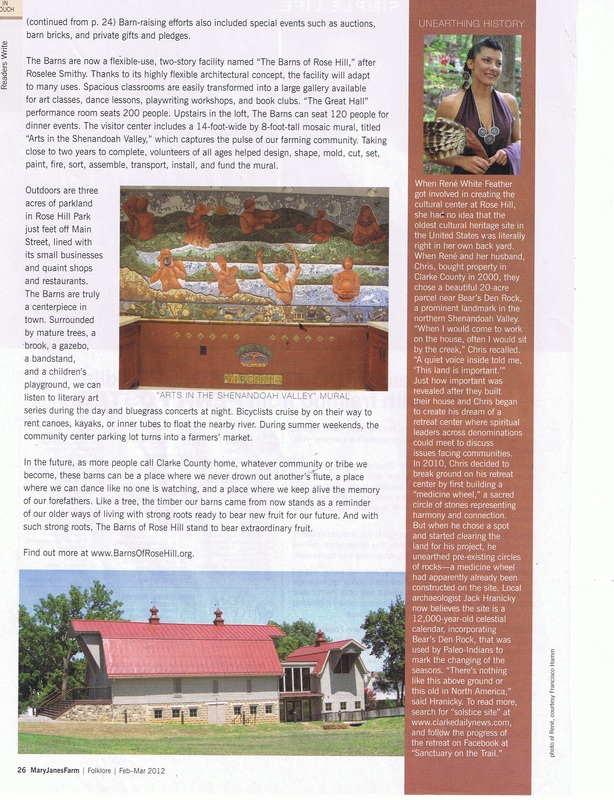| By Edward Leonard Clarke Daily News The site of a possible Paleo-Indian solstice site recently discovered in Clarke County, Virginia gained new interest among members and guests who attended the Northern Virginia Chapter of the Archeological Society of Virginia (NVCASV) during its monthly meeting in January. Lead archaeologist for the site, Jack Hranicky, announced new findings to including what Hranicky believes are stone art carvings located in rocks near the area of the initial discovery. “A new major feature is a shelter on the site that contains Indian rockart including A set of geometric ‘glyphs’ and two sets of right-hand prints,” Hranicky briefed the 32 NVCASV members at the Falls Church James Lee Community Center, who attended to hear his results of this three-year investigation into Northern Virginia’s archeology. “Glyphs” or petroglyphs, are rock engravings created by removing part of a rock surface with carving, picking, incising or abrading. The human hand is one of the most common rockart elements found around the world. Petroglyphs are found worldwide, but few are found in Virginia. There are 17 known rockart sites in Virginia, all recorded by Hrankicy. Hranicky has two other rockart sites containing concentric rings, altar and hand glyphs. Hranicky believes that the Clarke County Spout-Run complex pre-dates all of his previous discoveries. Hranicky explained that the Spout-Run “petroglyphs” should not be confused with “pictographs” – images drawn on rocks. “These petroglyphs were cut out of the stone” Harnicky said. Hranicky says that further studies would be needed to reveal when, why and by whom the petroglyphs were created. “We began with rock rings, now we have a 2-mile complex with 15 above-ground features including two sets of hand prints,” reported Hranicky. He went on to describe the early people who roamed the area approximately 12,000 years ago as “Virginia’s first Engineers.” During his one-hour presentation Hranicky explained the Spout Run site’s defining characteristics including direct alignment with both solar solstices, alignment east-to-west with the seasonal equinoxes, the site’s lunar focus, stone concentric rings and fire hearth as well as the site’s major feature, a stone altar which also aligns with the summer solstice. When Hranicky announced finding heat-treated jasper near the surface, excitement buzzed through the room. He also revealed finding a bolder set which appears to have stood more than 40-feet tall at one time. Hranicky told the group that the Spout-Run site served Paleoindians in a number of ways, such as a calendar for the annual seasons and where social and spiritual ceremonies were conducted. Hranicky also said that the location also was used for flint-knapping activities as was the famous Thunderbird Paleosite in nearby Warren County, Virginia. | Spout-Run land owners Chris and René White attended Hranicky’s presentation and received recognition from NVCASV members for their contributions. When asked what he planned to do with the site Chirs White said, “Preserve it for future generations.” At the conclusion of Hranicky’s presentation, NVCASV Chapter President John Kelsey opened the floor for questions and discussions. Topics ranged from concerns about assigning current cultural meanings to accurately explain paleo-culture; and how the degree of repatination on the rockart may also indicate relative dating. Hranicky is scheduled to deliver his Spout-Run brief at the Mid-Atlantic Archeological Conference in Virginia Beach, Virginia on March 22-25 and then again for the Society for American Archeology’s 77th annual meeting in Memphis, Tennessee on April 20. Hranicky plans to publish a final paper on the Spout-Run site before the end of the year. Meanwhile, Chris and René White, both Native American descendants, aim to return the site back to the way the Paleoindians left it. They and Hranicky are exploring appropriate ways to study the site, such as ground penetrating radar and advanced stone technology. The Whites are also studying the feasibility of establishing a sacred retreat that they have named “Sanctuary on the Trail”, a faith-based neighborhood and community outreach-initiative where spiritual leaders across denominations can meet to create possibilities for communities, churches and tribes on challenges and issues facing them. Last year, White and Hranicky coined the name Spout-Run for the site after the creek that runs through it. Hranicky has since described the complex as the oldest, extent, above-ground site in North America. Due to its location in some of the roughest terrain in Northern Virginia, Hranicky said, the Spout-Run site laid open on the ground just as the Paleoindians left it 12,000 years ago. Over the years, while trees have grown and been harvested across some of the site, there is no sign trees grew inside the concentric rings. The complex is remote, isolated and appears relatively undisturbed, other than by climate affects. After discovering the site in 2009, landowner Chris White brought it to Hranicky’s attention in 2010. Hranicky immediately recognized it as a possible Paleoindian site and with a 5-foot x 5-foot excavation in 2011, Hranicky established the site a Paleoindian. Later in 2011, Virginia’s Department of Historic Resources added the Spout-Run site to the state’s inventory of archaeological sites. Hranicky, a resident of the Washington, D.C. area for 51 years, has been practicing archaeology for over 40 years in Virginia and is the director of the Virginia Rockart Survey. He has found, recorded, and published five prehistoric solstice sites in the Mid-Atlantic region and has published 32 books on Native American pre-history. |
|
0 Comments
|
Paleo News Room
for the site discovered by Chris (Comeswithclouds) White in 2010 Topics
All
History
August 2020
|


 RSS Feed
RSS Feed